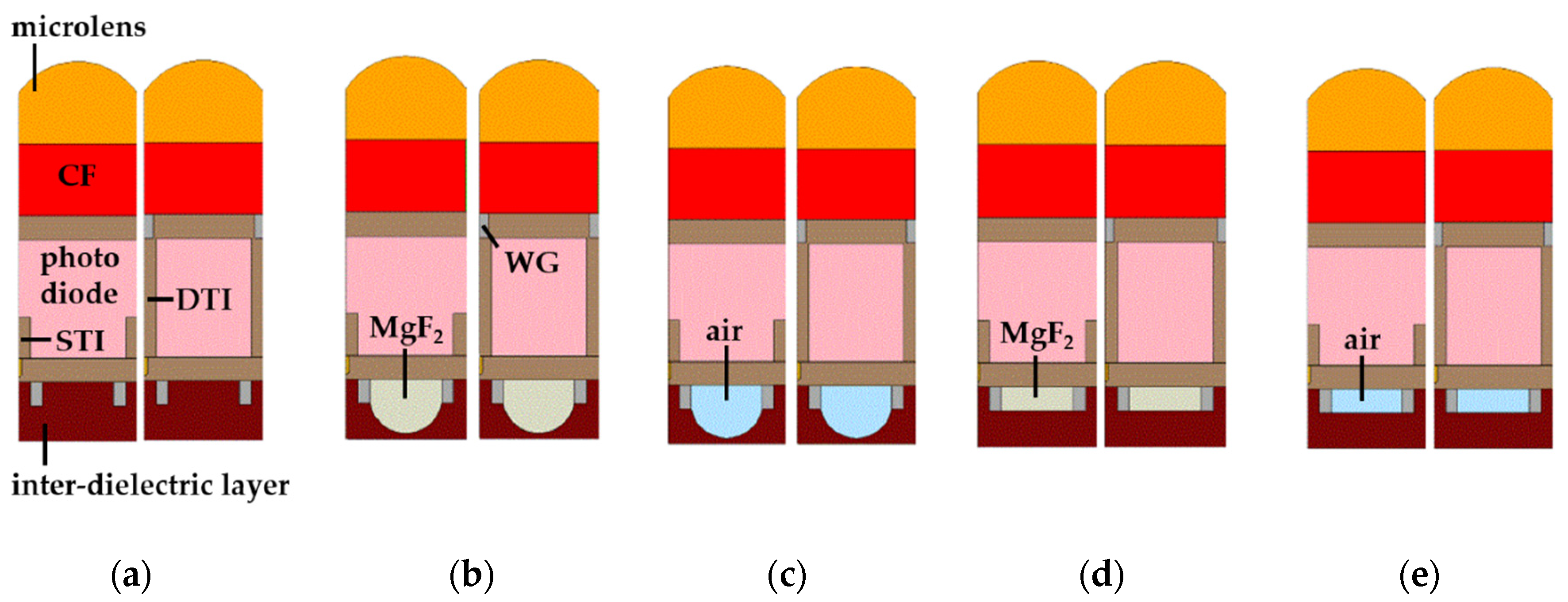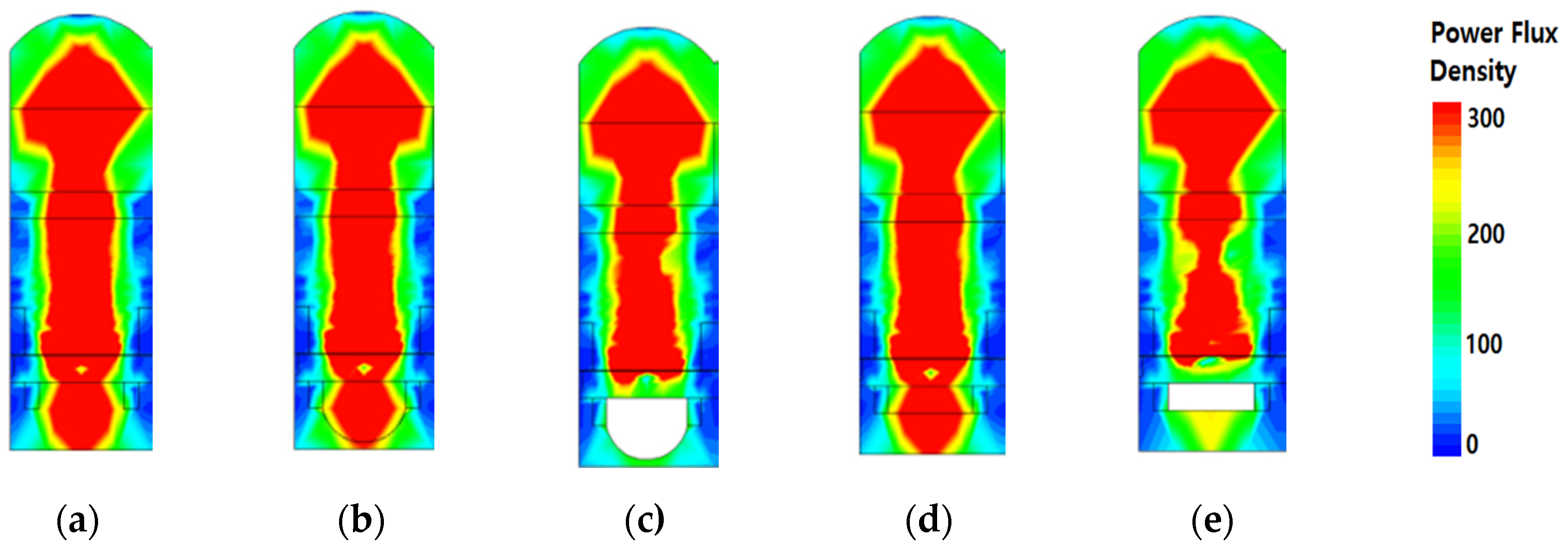Front-Inner Lens for High Sensitivity of CMOS Image Sensors
Abstract
:1. Introduction
2. Concept of the Front-Inner Lens
3. Simulation Results
4. Conclusions
Author Contributions
Funding
Conflicts of Interest
References
- Rec. ITU-R BT.2020-1. Parameter Values for Ultra-High Definition Television Systems for Production and International Programme Exchange; ITU: Geneva, Switzerland, 2014. [Google Scholar]
- Kitamura, K.; Watabe, T.; Sawamoto, T.; Kosugi, T.; Akahori, T.; Iida, T.; Isobe, K.; Watanabe, T.; Shimamoto, H.; Ohtake, H.; et al. A 33-megapixel 120-frames-per-second 2.5-watt CMOS image sensor with column-parallel two-stage cyclic analog-to-digital converters. IEEE Trans. Electron Devices 2012, 59, 3426–3433. [Google Scholar] [CrossRef]
- Nishimura, K.; Shishido, S.; Miyake, Y.; Yanagida, M.; Satou, Y.; Shouho, M.; Kanehara, H.; Sakaida, R.; Sato, Y.; Hirase, J.; et al. An 8K4K-resolution 60fps 450ke-saturation-signal organic-photoconductive-film global-shutter CMOS image sensor with in-pixel noise canceller. In Proceedings of the 2018 IEEE International Solid - State Circuits Conference, San Francisco, CA, USA, 11–15 February 2018. [Google Scholar]
- Funatsu, R.; Huang, S.; Yamashita, T.; Stevulak, K.; Rysinski, J.; Estrada, D.; Yan, S.; Soeno, T.; Nakamura, T.; Hayashida, T.; et al. 133Mpixel 60fps CMOS image sensor with 32-column shared high-speed column-parallel SAR ADCs. In Proceedings of the 2015 IEEE International Solid-State Circuits Conference (ISSCC), San Francisco, CA, USA, 22–26 February 2015. [Google Scholar]
- Sakiyama, T.; Yamashita, T.; Hanatani, T.; Mitsuhashi, S. Newly developed 8K/HLG broadcasting camera system with three CMOS image sensors. SMPTE Motion Imaging J. 2018, 127, 1–6. [Google Scholar] [CrossRef]
- Arai, T.; Yasue, T.; Kitamura, K.; Shimamoto, H.; Kosugi, T.; Jun, S.; Aoyama, S.; Hsu, M.C.; Yamashita, Y.; Sumi, H.; et al. A 1.1 µm 33Mpixel 240fps 3D-stacked CMOS image sensor with 3-stage cyclic-based analog-to-digital converters. In Proceedings of the 2016 IEEE International Solid-State Circuits Conference (ISSCC), San Francisco, CA, USA, 31 January–4 February 2016. [Google Scholar]
- Yonemoto, K. CCD/CMOS Fundamentals and Applications of Image Sensors; CQ Publishing Co., Ltd.: Bunkyo City, Tokyo, Japan, 2003; pp. 38–40. ISBN 4-7898-3626-6. [Google Scholar]
- Iwabuchi, S.; Maruyama, Y.; Ohgishi, Y.; Muramatsu, M.; Karasawa, N.; Hirayama, T. A back-illuminated high-sensitivity small-pixel color CMOS image sensor with flexible layout of metal wiring. In Proceedings of the 2006 IEEE International Solid State Circuits Conference, San Francisco, CA, USA, 6–9 February 2006. [Google Scholar]
- Ahn, J.; Lee, K.; Kim, Y.; Jeong, H.; Kim, B.; Kim, H.; Park, J.; Jung, T.; Park, W.; Lee, T.; et al. A 1/4-inch 8Mpixel CMOS image sensor with 3D backside-illuminated 1.12 μm pixel with front-side deep-trench isolation and vertical transfer gate. In Proceedings of the 2014 IEEE International Solid-State Circuits Conference Digest of Technical Papers, San Francisco, CA, USA, 9–13 February 2014. [Google Scholar]
- Cho, S.H.; Park, Y.S. Micro Lens, Device Employing the Same, And Method of Manufacturing the Same. U.S. Patent 2013/0188257 A1, 25 June 2013. [Google Scholar]
- Yu, C.-H. Image Sensor Device with Color Filters and Manufacturing Method Thereof. U.S. Patent 7,180,044 B2, 20 February 2007. [Google Scholar]
- Wakabayashi, H.; Yamaguchi, K.; Okano, M.; Kuramochi, S.; Kumagai, O.; Sakane, S.; Ito, M.; Hatano, M.; Kikuchi, M.; Yamagata, Y.; et al. A 1/2.3-inch 10.3Mpixel 50frame/s Back-Illuminated CMOS image sensor. In Proceedings of the 2010 IEEE International Solid-State Circuits Conference, San Francisco, CA, USA, 7–11 February 2010. [Google Scholar]
- Shinohara, T.; Watanabe, K.; Arakawa, S.; Kawashima, H.; Kawashima, A.; Abe, T.; Yanagita, T.; Ohta, K.; Inada, Y.; Onizuka, M.; et al. Three-dimensional structures for high saturation signals and crosstalk suppression in 1.20 μm pixel back-illuminated CMOS image sensor. In Proceedings of the 2013 IEEE International Electron Devices Meeting, Washington, DC, USA, 9–11 December 2013. [Google Scholar]
- Watanabe, H.; Hirai, J.; Katsuno, M.; Tachikawa, K.; Tsuji, S.; Kataoka, M.; Kawagishi, S.; Kubo, H.; Yano, H.; Suzuki, S.; et al. A 1.4 µm front-side illuminated image sensor with novel light guiding structure consisting of stacked lightpipes. In Proceedings of the 2011 International Electron Devices Meeting, Washington, DC, USA, 5–7 December 2011. [Google Scholar]
- Fontaine, R. The State-of-the-Art of Mainstream CMOS Image Sensors. In Proceedings of the 2015 International Image Sensor Workshop (IISW), Vaals, The Netherlands, 8–11 June 2015. [Google Scholar]
- Kim, H.K.; Kim, B.; Kim, J.; Park, J.; Lee, Y.; Jung, T.; Lee, K.; Jung, H.; Moon, C.; Ahn, J.; et al. Development of lensed color filter technology for higher SNR and lower crosstalk CMOS image sensor. In Proceedings of the 2013 International Image Sensor Workshop (IISW), Snowbird Resort, UT, USA, 12–16 June 2013. [Google Scholar]
- Lee, J.K.; Kim, A.; Kang, D.W.; Lee, B.Y. Efficiency enhancement in a backside illuminated 1.12 μm pixel CMOS image sensor via parabolic color filters. Opt. Express 2016, 24, 16027–16036. [Google Scholar]
- Moon, C.-R.; Lee, D.-H.; Cho, S.-H. CMOS image sensors including backside illumination structure. U.S. Patent No. 8,164,126, 24 April 2012. [Google Scholar]
- Yaung, D.N. CMOS Image Sensor Device and Method. U.S. Patent 6,946,352 B2, 20 September 2005. [Google Scholar]
- Dodge, M.J. Refractive properties of magnesium fluoride. Appl. Opt. 1984, 23, 1980–1985. [Google Scholar] [CrossRef]
- Sentaurus TCAD. Available online: https://www.synopsys.com/ (accessed on 21 February 2019).
- Venezia, V.C.; Hsiung, A.C.; Yang, W.Z.; Zhang, Y.; Zhao, C.; Lin, Z.; Grant, L.A. Second generation small pixel technology using hybrid bond stacking. Sensors 2018, 18, 667. [Google Scholar] [CrossRef] [PubMed]
- Yokoyama, T.; Tsutsui, M.; Suzuki, M.; Nishi, Y.; Mizuno, I.; Lahav, A. Development of low parasitic light sensitivity and low dark current 2.8 μm global shutter pixel. Sensors 2018, 18, 349. [Google Scholar] [CrossRef] [PubMed]






| Pixel structure | Pixel pitch | 1.0 µm |
| Pixel depths | 3.0, 2.0, 1.0 µm | |
| Height & ROC of micro lens | 0.6 µm | |
| Height & ROC of front-inner lens | 0.25 µm/0.3 µm | |
| Width of WG | 0.075 µm | |
| Height of WG | 0.2 µm | |
| width of STI, DTI | 0.1 µm | |
| Height of STI | 0.35 µm | |
| DTI depths | 3.0, 2.0, 1.0 µm | |
| Materials | Refractive index of MgF2 & Air | 1.3767 (650 nm)/1.0 (650 nm) |
| Incident light | Wavelength | 650 nm |
| Incident angle | 0°, 10°, 20° |
© 2019 by the authors. Licensee MDPI, Basel, Switzerland. This article is an open access article distributed under the terms and conditions of the Creative Commons Attribution (CC BY) license (http://creativecommons.org/licenses/by/4.0/).
Share and Cite
Seok, G.; Kim, Y. Front-Inner Lens for High Sensitivity of CMOS Image Sensors. Sensors 2019, 19, 1536. https://doi.org/10.3390/s19071536
Seok G, Kim Y. Front-Inner Lens for High Sensitivity of CMOS Image Sensors. Sensors. 2019; 19(7):1536. https://doi.org/10.3390/s19071536
Chicago/Turabian StyleSeok, Godeun, and Yunkyung Kim. 2019. "Front-Inner Lens for High Sensitivity of CMOS Image Sensors" Sensors 19, no. 7: 1536. https://doi.org/10.3390/s19071536
APA StyleSeok, G., & Kim, Y. (2019). Front-Inner Lens for High Sensitivity of CMOS Image Sensors. Sensors, 19(7), 1536. https://doi.org/10.3390/s19071536





